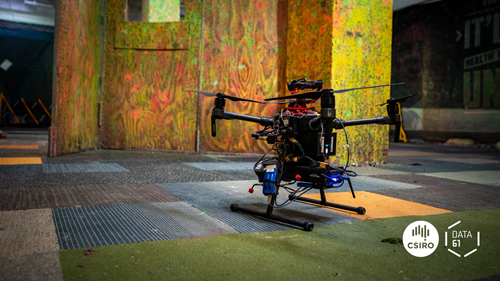CSIRO-led team to represent Australia in DARPA Challenge

A Brisbane-based team of robotics experts from CSIRO’s Data61 and a spin-off company will represent Australia in by the US Defense Advanced Research Projects Agency (DARPA) Subterranean Challenge to be held in the United States on 21-23 September.
Experts from around the world have spent the past three years pushing the boundaries of autonomous robotic technology to map, navigate and search environments as part of the DARPA Challenge. With teams eliminated from the competition each year, only eight remain to contest the 2021 grand final.
The six autonomous land-based robots from CSIRO’s Data61 team will need to locate and report back on items and environmental conditions throughout three underground courses built inside the Louisville Mega Cavern in Louisville, Kentucky.
The challenges are designed to simulate real-world scenarios and involve locating models representing lost or injured humans, backpacks, or phones, as well as variable conditions such as pockets of gas. Points are awarded for correct identification and location of items, mapping the terrain, and maintaining autonomy and communications throughout.
Each land-bound robot is equipped with hardware designed and developed by CSIRO’s Data61 for highly accurate mapping, localisation, object detection, multi-bot navigation, Bluetooth and Wi-Fi detection and more. This includes a state-of-the-art perception system equipped with Wildcat SLAM (Simultaneous Localisation and Mapping) software, which enables a vehicle to become autonomous and undertake a mission without human intervention. The team’s tracked robots were purchased from Australian robotics company BIA5.
The Australian team’s aerial robots taking part in the Challenge are designed and developed by CSIRO spinout and partner Emesent, and are equipped with the Emesent Hovermap systems which provide state-of-the-art mapping and autonomy capabilities.
The winner will receive $US2 million to conduct further research and development, with second place awarded $US1 million and third $US500,000. CSIRO’s Data61 placed fourth in the previous challenge to secure their place in this grand final.
Breakthroughs discovered so far through the DARPA Challenge have helped push real-world applications forward, including improving safety and enhanced efficiency in local mining sectors, and promising significant potential in agriculture and manufacturing.
“Having a fleet of driving, walking and flying robots that are achieving complex missions autonomously and collaboratively is a major technological milestone and an important step towards using autonomous systems for saving lives and helping people,” says Dr Farid Kendoul, CTO and co-founder of Emesent, a CSIRO spinout and DARPA Challenge partner that worked closely with CSIRO to develop two autonomous drones that will explore, map and report back on the course.
The DARPA Subterranean Final Challenge will take place from 21-23 September GMT4: https://www.subtchallenge.com/
